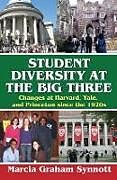Student Diversity at the Big Three
Einband:
Fester Einband
EAN:
9781412814614
Untertitel:
Changes at Harvard, Yale, and Princeton Since the 1920s
Genre:
Pädagogik
Autor:
Marcia Synnott
Herausgeber:
Taylor and Francis
Anzahl Seiten:
386
Erscheinungsdatum:
30.09.2013
ISBN:
978-1-4128-1461-4
Informationen zum Autor Marcia Synnott Strengthening affirmative action programs and fighting discrimination present challenges to America's best private and public universities. US college enrollments swelled from 2.6 million students in 1955 to 17.5 million by 2005. Ivy League universities, specifically Harvard, Yale, and Princeton, face significant challenges in maintaining their professed goal to educate a reasonable number of students from all ethnic, racial, religious, and socio-economic groups while maintaining the loyalty of their alumni. College admissions officers in these elite universities have the daunting task of selecting a balanced student body. Added to their challenges, the economic recession of 2008-2009 negatively impacted potential applicants from lower-income families. Evidence suggests that high Standard Aptitude Test (SAT) scores are correlated with a family's socioeconomic status. Thus, the problem of selecting the "best" students from an ever-increasing pool of applicants may render standardized admissions tests a less desirable selection mechanism. The next admissions battle may be whether well-endowed universities should commit themselves to a form of class-based affirmative action in order to balance the socioeconomic advantages of well-to-do families. Such a policy would improve prospects for students who may have ambitions for an education that is beyond their reach without preferential treatment. As in past decades, admissions policies may remain a question of balances and preferences. Nevertheless, the elite universities are handling admission decisions with determination and far less prejudice than in earlier eras. Zusammenfassung Strengthening affirmative action programs and fighting discrimination present challenges to America's best private and public universities. US college enrollments swelled from 2.6 million students in 1955 to 17.5 million by 2005. Ivy League universities, specifically Harvard, Yale, and Princeton, face significant challenges in maintaining their professed goal to educate a reasonable number of students from all ethnic, racial, religious, and socio-economic groups while maintaining the loyalty of their alumni. College admissions officers in these elite universities have the daunting task of selecting a balanced student body. Added to their challenges, the economic recession of 2008-2009 negatively impacted potential applicants from lower-income families. Evidence suggests that high Standard Aptitude Test (SAT) scores are correlated with a family's socioeconomic status. Thus, the problem of selecting the "best" students from an ever-increasing pool of applicants may render standardized admissions tests a less desirable selection mechanism. The next admissions battle may be whether well-endowed universities should commit themselves to a form of class-based affirmative action in order to balance the socioeconomic advantages of well-to-do families. Such a policy would improve prospects for students who may have ambitions for an education that is beyond their reach without preferential treatment. As in past decades, admissions policies may remain a question of balances and preferences. Nevertheless, the elite universities are handling admission decisions with determination and far less prejudice than in earlier eras. Inhaltsverzeichnis List of Tables Acknowledgments I. Introduction: Historical Perspectives on Admissions Policies at Harvard, Yale, and Princeton Universities II. From Margins to Mainstream: Jewish Students and Faculty at the Big Three III. Hesitant Courtships: Coeducation at Harvard, Yale, and Princeton IV. Affirmative Action and the Pursuit of Racial Diversity at Harvard, Yale, and Princeton Universities, 19602012 V. Invisible No Longer: Repeal of "Don't Ask, Don't Tell" Return of the ROTC; and Inclusion of LGBTQ Students and Students with Disabilities VI. Conclusion: Campus ...
Autorentext
Marcia Synnott
Klappentext
Strengthening affirmative action programs and fighting discrimination present challenges to America's best private and public universities. US college enrollments swelled from 2.6 million students in 1955 to 17.5 million by 2005. Ivy League universities, specifically Harvard, Yale, and Princeton, face significant challenges in maintaining their professed goal to educate a reasonable number of students from all ethnic, racial, religious, and socio-economic groups while maintaining the loyalty of their alumni. College admissions officers in these elite universities have the daunting task of selecting a balanced student body. Added to their challenges, the economic recession of 2008-2009 negatively impacted potential applicants from lower-income families. Evidence suggests that high Standard Aptitude Test (SAT) scores are correlated with a family's socioeconomic status. Thus, the problem of selecting the "best" students from an ever-increasing pool of applicants may render standardized admissions tests a less desirable selection mechanism. The next admissions battle may be whether well-endowed universities should commit themselves to a form of class-based affirmative action in order to balance the socioeconomic advantages of well-to-do families. Such a policy would improve prospects for students who may have ambitions for an education that is beyond their reach without preferential treatment. As in past decades, admissions policies may remain a question of balances and preferences. Nevertheless, the elite universities are handling admission decisions with determination and far less prejudice than in earlier eras.
Inhalt
List of Tables
Acknowledgments
I. Introduction: Historical Perspectives on Admissions Policies at Harvard, Yale, and Princeton Universities
II. From Margins to Mainstream: Jewish Students and Faculty at the Big Three
III. Hesitant Courtships: Coeducation at Harvard, Yale, and Princeton
IV. Affirmative Action and the Pursuit of Racial Diversity at Harvard, Yale, and Princeton Universities, 19602012
V. Invisible No Longer: Repeal of "Don't Ask, Don't Tell" Return of the ROTC; and Inclusion of LGBTQ Students and Students with Disabilities
VI. Conclusion: Campus Protests and New Elites at Harvard, Yale, and Princeton, 1960s2012
Bibliography
Index

Leider konnten wir für diesen Artikel keine Preise ermitteln ...
billigbuch.ch sucht jetzt für Sie die besten Angebote ...
Die aktuellen Verkaufspreise von 6 Onlineshops werden in Realtime abgefragt.
Sie können das gewünschte Produkt anschliessend direkt beim Anbieter Ihrer Wahl bestellen.
Loading...
Die aktuellen Verkaufspreise von 6 Onlineshops werden in Realtime abgefragt.
Sie können das gewünschte Produkt anschliessend direkt beim Anbieter Ihrer Wahl bestellen.
| # | Onlineshop | Preis CHF | Versand CHF | Total CHF | ||
|---|---|---|---|---|---|---|
| 1 | Seller | 0.00 | 0.00 | 0.00 |
